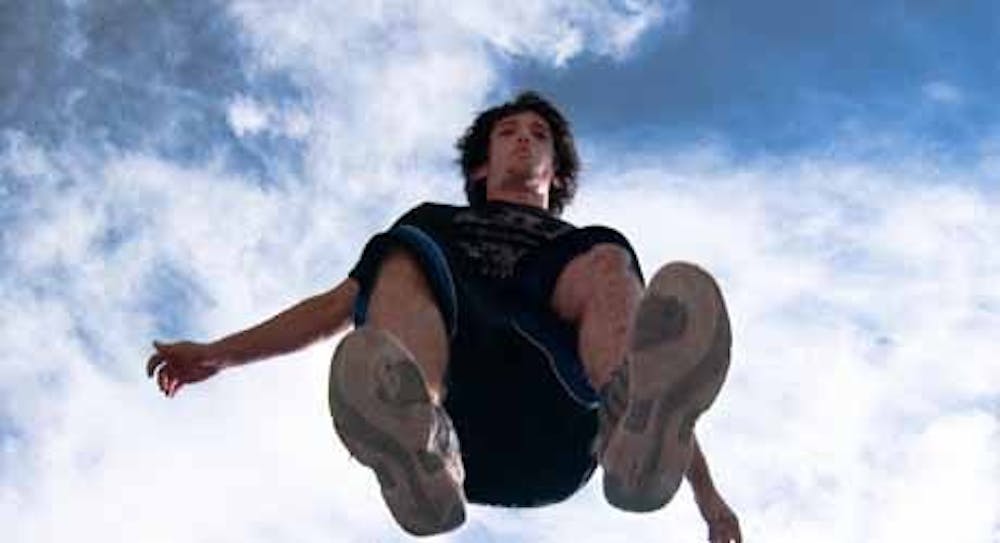Back flipping off 5-foot walls into a smooth somersault requires both confidence and intense training for traceurs, or practitioners of a sport called parkour.
“I don’t like to put a boundary on what parkour is,” said Judson Lowery, president of ASU’s parkour club. “It’s about efficiency and fluidity.”
Parkour is derived from the French word for “obstacle.” Traceurs combine acrobatics with free running, moving through an environment by overcoming seemingly impossible obstacles like solid brick walls.
State Press Television By Haley Buntrock
Global health junior Justin Martinez and Lowery, an English junior, founded the parkour club at the beginning of the fall semester. The club, called PK9000 — derived from the TV show “Dragon Ball Z” — trains three times a week in the art of overcoming obstacles.
Club members are applying for official club status next week, Martinez said, and they welcome anyone interested in the sport.
Eventually they hope to organize parkour competitions and events to promote not only parkour, but also a healthy lifestyle, he said.
“Parkour helps us to be stronger, healthier and to stay away from alcohol, drugs and unhealthy foods,” Martinez said. It’s a holistic sport that not only focuses on the development of skills but also on the health of the body and mind, he said.
There are about five members who attend practice both in the gyms at the Student Recreation Complex and on structures on campus, he said.
Lowery said the main goal of the club is to grow over the next semester.
Although a background in acrobatics is helpful, some members in the club began without prior acrobatic experience, Lowery said.
Several members of the club began practicing at the Student Recreation Complex through the (MA)trix classes, taught on campus by Francesco Caban, a Dance Education ASU graduate. His classes focus on parkour, acrobatics and break dance.
Caban said he started studying parkour more than four years ago and has continued to seriously pursue the sport.
Caban is currently applying for endorsements from companies to compete professionally. He also trained in London for a month with Parkour Generations, a professional parkour training company.
He said he believes any able-bodied person interested in parkour can master basic acrobatic skills like back flipping.
“You are going to be more sore then you ever thought possible and you’re going to have more fun then you ever thought possible,” Caban said.
Parkour originated in France and has spread across the United States, although it has been slow to catch on in an organized way in Arizona, Caban said.
Organizations including MTV’s Ultimate Parkour Challenge, Art of Motion sponsored by Red Bull and Parkour Visions, are moving toward a professional competitive model similar to the X-Games, Caban said.
These events test the athletes’ speed and acrobatic skills, Caban said.
Lowery said beginners learn how to hit the floor and roll in order to prevent injuries, and this provides a basis on which to build other skills.
Falling is a part of the high-risk sport, but it is important for practitioners to experience and learn how to do correctly, Caban said. They begin their training inside on mats and trampolines.
Fear of falling is a big obstacle for beginners to overcome, Lowery said, but it also helps to protect the parkour practitioners from hurting themselves.
“If you are afraid to fall, you will fall,” Lowery said.
Josh Anderson, member and mechanical engineering sophomore, said the challenge of parkour provides a release from school.
“I don’t think you are living if you don’t test yourself,” Anderson said.
Club member and Highland High School junior Adam Fellman said he was inspired to practice parkour by videos on YouTube two years ago.
“I’ve never really liked any other sport,” Fellman said.
Many other people in Arizona discovered parkour through YouTube and began practicing on their own, Caban said.
However, he said practitioners can only progress so far using online videos.
“Nothing is going to replace one-on-one instruction,” Caban said.
Reach the reporter mary.shinn@asu.edu





